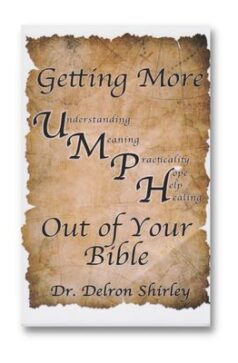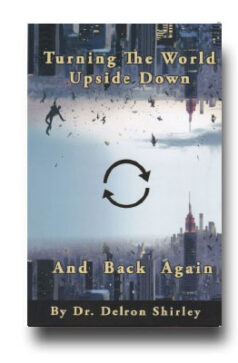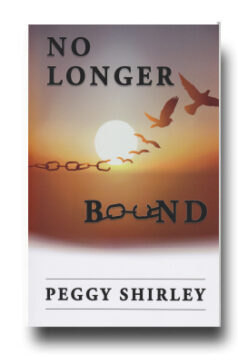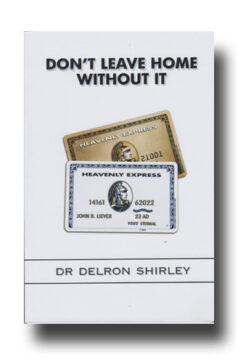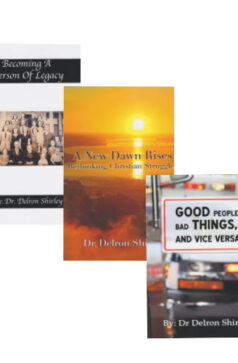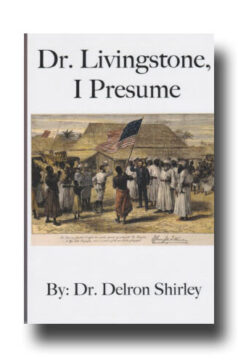Why the Crucifixion?
When I first heard of Mel Gibson’s plan to produce the movie The Passion of the Christ, I began following with avid interest every news article I could find about the film, and I wasted no time in getting to the theater to see it as soon as it was released. I knew that Mr. Gibson took a lot of criticism over the production, with the basic accusations being that the film is violent and full of hatred rather than being a story of the teacher of love, not historically accurate, and anti-Semitic.
Certainly, the film was violent. Any accurate depiction of the crucifixion would have to be violent. I personally believe that Jesus’ agony was the most violent moment in all of human history. It was the focal point of all the devil’s hatred in which he released every ounce of his hostility toward God and man, focusing it all on one central figure – Jesus of Nazareth. We have lived too many centuries with an innocuous image of the cross. The paintings we see show Jesus with a few drops of blood on His hands, feet, and brow and a smile on His face. I remember hearing one artist tell of how he had painted the fists of the Savior clinched around the heads of the nails but went back and repainted the hands with the fingers opened because he couldn’t believe that Jesus was actually enduring pain. But with this movie, Mel Gibson finally came forward to depict the cross in all the reality of the violence of the event.
Having seen Mel Gibson in the execution scene of Braveheart, I thought that I was prepared for the realistic portrayal he was to give in this movie. Man, was I ever wrong! I can honestly say that this was the most emotionally draining experience I have ever endured. I couldn’t keep my eyes on the screen during much of the flogging and crucifixion. The movie made Isaiah 53:3, We hid our faces from Him, a reality for me. I tore a fistful of napkins to shreds as I wrung my hands throughout the agonizing drama. I remember thinking that, finally, I was going to get a little relief when I saw the soldiers begin to unchain Jesus from the whipping post – only to find that they were simply turning Him over so they could lash Him across the chest!
Yes, it is a film about violence and hatred; however, throughout the film, Jesus is continually shown as the man of love who could pray that the Father would forgive His executioners – no matter how violent and full of hatred they might be. My guess is that the critics who see only violence are blinded to the rest because they just don’t want to let their own sinfulness and hatred toward God be exposed. They love darkness and want to remain in it because their deeds are evil.
Some of the movie critics have said that the screenplay is not historically accurate; however, after having spent years studying the Bible and the history of the time, I concur with the Pope’s analysis: “The way it is is the way it was.” Other than a few character roles added to carry the plot of the story, everything was historically accurate – down to the scene where the crow ate the malefactor’s eyeball. Although we don’t know that it happened to this particular individual, we do know that, many times, the jackals and vultures started eating the flesh of crucifixion victims while they lingered between life and death on their crosses. And the first morsel that the birds of prey go for is the eyeball!
The most vocalized criticism is that the movie is anti-Semitic. However, the plot follows history accurately, depicting exactly what part the Romans played and what the Jews had to do with Jesus’ death. In a pre-release airing of the film among some of the leading figures in Washington, DC, the question of whether the film had an anti-Jewish tone was asked at the conclusion of the film. For a very long moment, no one responded to the query, “Who killed Jesus?” Finally, one brave soul spoke out, “It was my sins that put Him on that cross!” That is exactly what Mel Gibson portrayed. Even before the first character graced the stage, the audience was forewarned about the message of the film as the words of Isaiah are scrolled across the screen: But he was wounded for our transgressions, he was bruised for our iniquities: the chastisement of our peace was upon him; and with his stripes we are healed. In a major headline USA TODAY quoted Mel Gibson as saying, “If I were Billy Graham, I would preach.” Well, he did! That one quote proclaimed the message of the cross; it is not against the Jews or the Romans – but against the sinfulness that has enslaved us all: Jews, Romans, Americans, etc.
The rest of my thoughts come from a lesson I gave in a Bible college class one day many years ago. One of the students who heard the message related a story the next day to describe the impact it had upon him. After class, he left for his job as a truck driver. Between South Bend, IN, and Chicago, IL, he was pulled over by a highway patrolman who wanted to know why he was driving so slowly; his rig was obstructing traffic on the busy highway. When my student responded that he had to drive slowly because it was raining so hard, the officer looked at him with a really funny expression and retorted, “It’s a perfectly clear day. What are you talking about?” My student’s response was that he was not talking about outside rain, but the rain inside his cab where he was weeping uncontrollably. When he explained to the policeman that he was just reviewing the lesson he had learned that day about the cross of Christ, the patrolman waved him on. The unbelievable part of the story is that the same officer stopped him again on his return trip to South Bend and again found him with tears running down his cheeks. If the verbal description can have this kind of effect, you can only imagine how dramatically the visual presentation impacts the viewers. My wife was so awestricken that she couldn’t move out of her seat after the viewing. I had to ask her to leave the room so the cleaning crew could vacuum under our chairs.
And I, brethren, when I came to you, came not with excellency of speech or of wisdom, declaring unto you the testimony of God. For I determined not to know any thing among you, save Jesus Christ, and him crucified. (I Corinthians 2:1-2) Paul said that he determined to focus his ministry on the cross. If he wanted people to see the cross, it must have something to say. Paul was probably the most eloquent man who ever proclaimed the gospel of Jesus – or any other message for that matter. He was trained in the best institutions which money could avail in the first century. He was the private pupil of Gamaliel – a rabbi who is honored even today as one of the ten most brilliant teachers of Judaism of all times. Paul had the authority of the Romans, the culture of the Greeks, and the heritage of the Jews converging inside him to make him superior on any playing field, yet he knew that there was still one more factor inside him which outweighed them all – the revelation of the cross of Christ!
I don’t believe that very many Christians of any background have ever totally realized what our Savior endured when He submitted Himself to death on the cross. We have all seen too many movies, Passion plays, paintings, and statues that depict the event without the true drama. We have come to believe that the cross was far less than it really was. Our paintings show a few little spots of blood around the points where the nails and the thorns penetrated the flesh of our messiah. He is usually depicted with a smile, or at least, a tranquil expression on His face. However, the scriptures and history paint a dramatically different portrait of a man on the crucifixion tree. The prophets tell us that His visage (facial features) was marred beyond that of any man and that there was nothing about Him that would cause us to want to look at Him – in fact, we would want to turn our heads away in awe and disgust. He was so disfigured that we couldn’t believe that we were really seeing a human being, not a piece of meat from the slaughterhouse. His beard was yanked from his face. We all know how it smarts to even ever-so-gingerly pull off a bandage which extracts only a few hairs in the process, but just imagine how agonizing it must have been when the soldiers grabbed handfuls of Jesus’ beard and jerked them out, yanking out large hunks of flesh along with them.
Crucifixion was only the last step in an intensely cruel execution process. Jesus’ agony actually began the evening before when He struggled for three solid hours with the challenge of facing the cross. Even though Jesus had consented to the crucifixion plan before the foundation of the earth – when the time for actually going to the cross drew near, He reacted the same as any other human being would have done. Anything else would have violated His humanity. Since He was every bit as mortal as you or I, every nerve ending in His body was as sensitive as those in any other human’s body. He knew that the pain that awaited Him was going to be real and that it would be of an intensity that would defy description. Jesus, who had lived every moment of His human life in total relationship with the Heavenly Father, took three full hours to come to the place to submit Himself to this one aspect of the Father’s plan; this proves the agony that was to come. If the cross were as benign as we see it portrayed, Jesus would not have been so resistant to accepting it. But it took three hours of travail in which Jesus longed for the human support that had failed Him and, finally, had to be succored by angelic nurturers. So intense was His struggle, the capillaries in His forehead burst and allowed blood to ooze through His skin, mixing with the perspiration pouring from his brow. The garden where He prayed was called “Gethsemane,” named after an olive press that was there. How symbolic of the pressing, tearing, and grinding which Jesus endured there, resulting in the squeezing out of His life’s blood just as the oil was squeezed out of the olives in the press. At last, the triumph came when Jesus could victoriously yield with the memorable words, Not my will, but thine be done.
Next came the arrest and interrogation and finally the trial before Pilate. This Roman governor had a reputation in Israel for being somewhat of a coward in that he had fairly readily withdrawn his troops after the Jewish leaders had shown a unified resistance when the Roman soldiers had tried to mount certain pagan symbols in Jerusalem. At first, he had ordered his men to draw their swords, but when the Orthodox Jews bared their necks indicating that they were willing to die for their beliefs, he reluctantly tucked his tail and recognized that he had met his match. The trial of Jesus was to be round two in the ongoing match between the procurator and the “cloth.” Pilate, immediately recognizing that the accused was faultless, set out to have Him released. Since no crime against Roman law could be cited, he tried to dismiss the case. The people pressed, and he yielded by allowing Jesus to be beaten.
It is likely that we will never totally comprehend the horror of the Roman whipping post. Here, a man was stripped and tied down so that the officers would have full exposure to his back. Their whips were leather thongs with sharp bits of metal, bone, or glass imbedded so that they would not just lash but also claw the flesh of the victim. With a skilled twist of the wrist as the lash stuck the victim’s back, the barb would embed in the flesh and plow across the back, leaving a furrow like a plowed field. Hunks of flesh were torn from the back and blood gushed uncontrollably. History records that in some cases the internal organs were actually visible through the gaping holes left by the Roman lash. Some men never made it to their crucifixions, having died from the injuries inflicted at the whipping post. Pilate’s hope was that he could show the crowd this bloody pulp of a man and satisfy their blood thirst. But the mob, likely remembering how they had previously forced the governor’s hand, insisted on crucifixion.
Like sharks in a feeding frenzy, the sight of blood only incensed them. Crowning Jesus with a crown made of a Judean bush which sports thorns of over two inches in length, it is certain that they inflicted more than mere flesh wounds in the brow of our Lord. Next, they thrust upon Him the cross He was to bear to Golgotha. Normally, we see this scene depicted with Jesus carrying the full cross; however, the more accurate historical likelihood is that He carried only the patibulum, the crossbeam. Yet He fell under the weight of just the cross beam, and the executioners had to force Simon of Cyrene to carry it to Calvary. We must remember that Jesus was a muscular and viral man in the prime of life who had spent His earlier years working in manual labor in His father’s carpenter shop and his last years traveling by foot through the rugged terrain of the near-desert terrain of the Middle East. The beating He had endured had so weakened this strong man that he couldn’t even carry the patibulum – much less a full cross. Finally, at the Place of the Skull, Jesus was nailed to the tree of execution. After the giant spikes ripped through His hands and feet, the cross was lifted into place and dropped into position in its support hole. The jar of lifting the cross to a vertical position and allowing gravity to yank it into the hole, followed by the reverberation of the thud as the cross hit the bottom of the hole and came to a sudden jerking halt, tore violently at the flesh around each nail hole. Writhing pains shot throughout His body. Jesus was offered wine mixed with myrrh to deaden His senses to relieve the pain, but He refused; the issue of enduring had been settled the evening before at the Rock of Agony in Gethsemane’s garden.
Some archeological evidence points to the fact that crosses of Jesus’ time were equipped with a seat that was actually a protrusion that would literally impale the victim unless he pulled himself away from its sharp point. Thus, the victim had to support himself by pulling up with his arms and pushing down with his legs, causing even more tearing of the flesh around the spikes. In addition to trying to avoid being impaled by the seat, the victim had to continually keep his arm muscles from relaxing in order to relieve the pull of the chest muscles that would eventually collapse his lungs and cause him to die of asphyxiation. Death on a cross was usually a long, drawn-out process; some men were reported to have survived for several days on the cross, finally dying of exposure or dehydration. It was also recorded that some crucifixion subjects became targets for vultures that actually began to eat their flesh while life still lingered.
In all this, I see the ultimate depravity of man. For a human being to ever think of such cruel and inhumane ways of torturing another human is unimaginable. Worse is the realization that those in charge had become so callous that they laughed and made a mockery of Jesus as they executed their gory task. The crowd sat down to watch and to jeer at this helpless subject of diabolic cruelty. The executioners gambled for His clothing while Jesus hung gasping for breath. Even worse is the thought that two men, who were enduring the same agonizing execution, joined in on the mocking of the Savior. How could someone going through such extreme pain want to use his precious breath and energy to scorn another victim? How could the crowd see the bloodied prisoner after the scourging and still beg for more? How could Pilate turn over a man he knew to be innocent to a lynch mob who was determined to do such an unthinkable thing to Him? There is only one answer: mankind is totally depraved!
The second thing I see when I survey that wondrous cross is the great love of God. As we have already mentioned, Jesus was the Lamb slain before the foundation of the earth. That means that, at some point before the Trinity made the decision to create the universe and place a planet called earth into orbit and then populate that planet with a species called man, They met together in divine council and came into total agreement concerning a plan of redemption for man’s inevitable fall. That plan consummated the total scope of God’s sacrifice. The Father would have to release His most beloved possession – His only begotten Son – to be humiliated, beaten, and executed; meanwhile, the Father would have to stand back without intervening to rescue Him. The Son would go through the ultimate of human suffering, inflicted by the very ones He was on mission to redeem. The Holy Spirit, with His power to convict men of their evil and the ability to comfort the sufferer, would have to deny His very nature and stand silently by as this great scenario played out. Imagine with me the creation week as God molded the features of the earth. As He sculpted the likeness of a skull into the side of a knoll in what would later be called Jerusalem, He knew what was to happen on the brow of that hill; yet, He made that hill anyway. As He spoke to the ground and told it to bring forth vegetation, He saw the first sprout of the family of trees that would eventually become execution trees; yet, He did not uproot it. As He called for animal life to inhabit the fields, he observed the first bull that would sire the bloodline of cattle that would provide the leather for the thongs of Roman whips; yet, He allowed it to mate and reproduce. As He planted His garden east in Eden, He knew exactly what would take place under the fruitful boughs of the Tree of the Knowledge of Good and Evil; yet He allowed it to sprout anyway. This was love at its greatest: God set up all the dominos knowing how they must fall. He made Himself totally vulnerable in order to love and redeem a race of men that He could have left uncreated! Relentlessly determined that the plan be fulfilled, He intervened in every strata of society and at every crisis point in history to see that all was on target for the day He would consummate His great love and initiate the Golden Text of the faith: For God so loved the world, that he gave his only begotten Son, that whosoever believeth in him should not perish, but have everlasting life. (John 3:16)
Jesus made the great love of the Godhead tangible and visible when He abdicated His position in the throne room of heaven to become one of us and submitted Himself to the agony of the cross.
And the Word was made flesh, and dwelt among us, (and we beheld his glory, the glory as of the only begotten of the Father,) full of grace and truth. (John 1:14)
Who, being in the form of God, thought it not robbery to be equal with God: But made himself of no reputation, and took upon him the form of a servant, and was made in the likeness of men: And being found in fashion as a man, he humbled himself, and became obedient unto death, even the death of the cross. (Philippians 2:6-8)
Looking unto Jesus the author and finisher of our faith; who for the joy that was set before him endured the cross, despising the shame, and is set down at the right hand of the throne of God. (Hebrews 12:2)
At the cross, we see this so clearly when we observe the determination with which He fulfilled His mission. In spite of His personal pain, He focused on mankind’s needs – not His own. Mustering up enough breath to stay alive would seem to be His main focus, but Jesus continued to use His waning energy and precious breath to minister to a world that was closer to spiritual death than He was to physical death. It may have been a barely audible whisper, but I suspect that it was hardly short of a bellow when Jesus proclaimed, Father, forgive them; for they know not what they do. (Luke 23:34) Unconcerned for His treasured breath, He expended Himself for us! As one of the malefactors who had, according to Matthew 27:44, thrown ridicule into Jesus’ teeth had a change of heart, Jesus again abandoned His struggle for His own breath to vocalize a promise of eternity and salvation to him. Paul described this great love which was manifest at the cross in Romans 5:10, For if, when we were enemies, we were reconciled to God by the death of his Son, much more, being reconciled, we shall be saved by his life.
The redemptive work of the cross totally eradicates sin, guilt, and bondage. The old sacrifice system provided a ceremonial way of dealing with error, but it stopped short of eradicating the guilt of its temporal and eternal consequences.
For if the blood of bulls and of goats, and the ashes of an heifer sprinkling the unclean, sanctifieth to the purifying of the flesh: How much more shall the blood of Christ, who through the eternal Spirit offered himself without spot to God, purge your conscience from dead works to serve the living God? (Hebrews 9:14)
From the cross, Jesus asked the Father for a blanket forgiveness for man’s sinfulness. When Paul experienced the redemptive work of the cross, he testified,
But God forbid that I should glory, save in the cross of our Lord Jesus Christ, by whom the world is crucified unto me, and I unto the world…I am crucified with Christ: nevertheless I live; yet not I, but Christ liveth in me: and the life which I now live in the flesh I live by the faith of the Son of God, who loved me, and gave himself for me. (Galatians 6:14, 2:20)
The cross freed him from the world’s guilt system and his old sinful self. Because of the cross, Paul could say that he had a new source of life within himself.
The Apostle Peter echoed Paul’s revelation when he writes, Who his own self bare our sins in his own body on the tree, that we, being dead to sins, should live unto righteousness: by whose stripes ye were healed. (I Peter 2:24) John shares his comprehension of this truth in his vision from Patmos, These are they which came out of great tribulation, and have washed their robes, and made them white in the blood of the Lamb. (Revelation 7:14) At the cross, I see the ultimate redemption which covers any and every sin, no matter how great or small; I see a redemption which really works, conquering the penalty, guilt, and nature of sin as well as just dealing with the act of sin.
Jesus prophesied that His cross would have a universal impact, And I, if I be lifted up from the earth, will draw all men unto me. (John 12 :32) It was not just the few people who actually nailed Him to the tree, or who plucked out His beard, or who spat on Him and blasphemed Him, or who wielded the cruel whip, for whom He prayed that the Father would forgive. It was for all men that He went to the cross.
On that cross, there was a bold proclamation in all the major languages of the time. Anyone who would have passed by the crucifixion grounds would have readily been able to identify the man and His mission. The cross, standing on the Damascus Road just outside the major gate to the city of Jerusalem, was in the most prominent place with the highest traffic volume in the vicinity. The amazement with which the disciples on the road to Emmaus questioned if Jesus were a stranger in the region since He seemed to have not heard about the cross testified to the effectiveness of the universal proclamation of that cross. As if a declaration to all men, the cross dominated the crossroads of commerce, military movement, religious pilgrimages, and everyday living. In the cross, I see that the crucifixion was not just a glimmer of hope to one sect or sector; it was a great beacon of salvation to the whole world. At the cross not only do I see God’s deliberate attempt to reach the whole of humankind, but I also sense the command which was to come after the cross had yielded to the victory of the resurrection, Go ye therefore, and teach all nations, baptizing them in the name of the Father, and of the Son, and of the Holy Ghost: Teaching them to observe all things whatsoever I have commanded you: and, lo, I am with you alway, even unto the end of the world. Amen. (Matthew 28:19-20)
The Broken Body and Spilled Blood
I hate to commit to paper and ink anything that may label me as a racist, bigot, or anti-Semitic; but no matter how I try to guard myself against profiling, I just can’t keep myself from calling Zebedee’s wife a stereotypic “Jewish mamma.” After all, who else would have come to Jesus asking for her two sons to be granted positions of authority on His right and left hands? It might have been a logical idea that the only two siblings in Jesus’ entourage be given those two prominent posts, but it certainly was presumptuous on her part to be the one who suggested it. Well, all that aside, Jesus really threw her a curveball when He answered her petition.
But Jesus answered and said, Ye know not what ye ask. Are ye able to drink of the cup that I shall drink of, and to be baptized with the baptism that I am baptized with? They say unto him, We are able. And he saith unto them, Ye shall drink indeed of my cup, and be baptized with the baptism that I am baptized with: but to sit on my right hand, and on my left, is not mine to give, but it shall be given to them for whom it is prepared of my Father. (Matthew 20:22-23, Mark 10:38-39)
Perhaps it isn’t too difficult to interpret His reference to being baptized with the baptism He was to endure. The Apostle Paul gives us a clear expose’ in Romans chapter six defining the baptism as symbolic of Christ’s death.
Know ye not, that so many of us as were baptized into Jesus Christ were baptized into his death? Therefore we are buried with him by baptism into death: that like as Christ was raised up from the dead by the glory of the Father, even so we also should walk in newness of life. For if we have been planted together in the likeness of his death, we shall be also in the likeness of his resurrection. (verses 3-5)
However, the reference to drinking the cup may be a bit more veiled unless we go back into the Old Testament to understand what was in that cup. According to the words of the prophets of the Lord, that cup was filled to the brim and sloshing over with the wrath of God.
Upon the wicked he shall rain snares, fire and brimstone, and an horrible tempest: this shall be the portion of their cup. (Psalm 11:6)
Therefore his people return hither: and waters of a full cup are wrung out to them. (Psalm 73:10)
For in the hand of the LORD there is a cup, and the wine is red; it is full of mixture; and he poureth out of the same: but the dregs thereof, all the wicked of the earth shall wring them out, and drink them. (Psalm 75:8)
Awake, awake, stand up, O Jerusalem, which hast drunk at the hand of the LORD the cup of his fury; thou hast drunken the dregs of the cup of trembling, and wrung them out. (Isaiah 51:17)
Thus saith thy Lord the LORD, and thy God that pleadeth the cause of his people, Behold, I have taken out of thine hand the cup of trembling, even the dregs of the cup of my fury; thou shalt no more drink it again. (Isaiah 51:22)
Babylon hath been a golden cup in the LORD’S hand, that made all the earth drunken: the nations have drunken of her wine; therefore the nations are mad. (Jeremiah 51:7)
Rejoice and be glad, O daughter of Edom, that dwellest in the land of Uz; the cup also shall pass through unto thee: thou shalt be drunken, and shalt make thyself naked. (Lamentations 4:21)
Thou hast walked in the way of thy sister; therefore will I give her cup into thine hand. Thus saith the Lord GOD; Thou shalt drink of thy sister’s cup deep and large: thou shalt be laughed to scorn and had in derision; it containeth much. Thou shalt be filled with drunkenness and sorrow, with the cup of astonishment and desolation, with the cup of thy sister Samaria. (Ezekiel 23:31-33)
Thou art filled with shame for glory: drink thou also, and let thy foreskin be uncovered: the cup of the LORD’S right hand shall be turned unto thee, and shameful spewing shall be on thy glory. (Habakkuk 2:16)
Behold, I will make Jerusalem a cup of trembling unto all the people round about, when they shall be in the siege both against Judah and against Jerusalem. (Zechariah 12:2) [emphases added]
Even in the concluding chapters of the Bible, the imagery of the vile contents of the Lord’s cup is again invoked to portray the wrath of the Lord toward the wickedness of the rebelliousness of mankind. The Lord even declares that He will fill the cup of Babylon double with all the wickedness she thrust upon the nations and force it back into her own hand.
The same shall drink of the wine of the wrath of God, which is poured out without mixture into the cup of his indignation; and he shall be tormented with fire and brimstone in the presence of the holy angels, and in the presence of the Lamb. (Revelation 14:10)
And the great city was divided into three parts, and the cities of the nations fell: and great Babylon came in remembrance before God, to give unto her the cup of the wine of the fierceness of his wrath. (Revelation 16:19)
And the woman was arrayed in purple and scarlet colour, and decked with gold and precious stones and pearls, having a golden cup in her hand full of abominations and filthiness of her fornication. (Revelation 17:4)
Reward her even as she rewarded you, and double unto her double according to her works: in the cup which she hath filled fill to her double. (Revelation 18:6) [emphases added]
Knowing that the cup He was ordained to imbibe brimmed with the unmitigated wrath of God against the totality of past, present, and future sinfulness, transgression, and iniquity of the whole human race; it is no wonder that Jesus agonized before His Father, petitioning for an alternate plan. In the Garden of Gethsemane, our Savior went through what was certainly the three longest and most agonizing hours of history – foreshadowing the three longest, most agonizing hours of eternity which were to come the next day as Jesus’ cross would be raised at noon and lowered again at three o’clock. The Garden of Gethsemane and the Rock of Agony themselves symbolized this epic event. Remember that “Gethsemane” is the Aramaic word for “olive press,” an instrument for tearing, shredding, squeezing and pulverizing the olive until the last drop of the precious oil is extracted. Just as the fruit of the olive is crushed until it releases its valuable juice, so also Jesus was pressed and squeezed until out of Him flowed the treasured life fluid of His very spirit, soul, and body.
When Jesus first approached the Rock of Agony, He left His disciples behind with the words, Pray that you may not enter into temptation. (Luke 22:40) The word “temptation” to the people of Jesus’ time meant “a fork in the road.” Temptation was the point where you had to decide your own destiny. It was an opportunity to fail or an opportunity to succeed. It was as Robert Frost put it: “The place in the yellow wood where two roads diverged.”
Jesus was warning His disciples of the challenge and the agony of coming to the place in life where you have to decide to take the path “less traveled by.” Jesus had arrived at this point. He had to choose to follow through with the eternal plan of redemption or to abort the divine mandate of the cross. That first hour of prayer was the struggle of His spirit: Father, if it is your will, take this cup away from me. (Luke 22:42) Here, the Savior had to settle once and for all the certainty of God’s will. He had to know without a shadow of a doubt that there was no other way to complete His mission. He had to remove even the faintest hint of question from His mind that the cross stood smack in the middle of His road of destiny. Time and again He had spoken of it – saying that He, as all prophets, must die in Jerusalem and that He would be “lifted up.” He had determined to fulfill God’s plan and “had set His face” resolutely to go to Jerusalem to play out that divine drama. Yet, His spirit man – the part of the human being that communes with God (here symbolized by the term “Abba,” the intimate word for “Daddy,” which Jesus used to speak of God in Mark 14:36) – still had to remove any question that there was no other option – no Plan B.
After finding His followers – and supposed supporters – asleep, He awoke them and announced that He had won a victory in His spirit man when He had capped that first hour of prayer with the words, Not My will, but Yours, be done. (Luke 22:42) But He added that there was still a battle for Him to win. Even though His spirit was willing, His flesh was still weak and resistant.
Jesus then entered into a second hour of prayer. This time, it was His soulical man that struggled. The scriptures describe this season of prayer with words like “troubled,” “sorrowful,” and “deeply distressed.” Jesus proclaimed, My soul is exceedingly sorrowful, even to death. (Mark 14:34, Matthew 26:38) His total mind, will, and emotions (the components of the soul) were stretched to the limits – and beyond – as Jesus agonized that second hour.
Finally, an angel appeared and strengthened Him as He was ready to enter into His third period of agony. It was in this final period that the scriptures record that He prayed more earnestly. (Luke 22:44) This hour of prayer was related to Jesus’ final segment of His personality, the fleshly man. This is symbolized by its conclusion when Jesus’ sweat burst forth like great drops of blood; His body was yielding to the great master plan in which the Lamb was to shed His blood for the remission of sin!
When the incensed mob came to arrest Jesus and Peter tried to defend Him by pulling out his sword, our Lord’s response showed His resolve to accept the cup of the Father’s wrath, Put up thy sword into the sheath: the cup which my Father hath given me, shall I not drink it? (John 18:11)
For me personally, the most amazing point of the whole story is found in Matthew 26:27, And he took the cup, and gave thanks… (also recorded in Mark 14:23 and Luke 22:17) Notice that this is the same chapter in which He confessed that His soul was sorrowful even unto death over having to take the cup and in which He prayed that the cup be removed, yet He gave thanks over the cup as He passed it to His disciples. How can this be? How is it possible to reconcile the two diametrically opposed ideas of giving thanks for the cup while at the same time praying that this cup could be bypassed? Perhaps the answer can be found in Hebrews 12:2:
Looking unto Jesus the author and finisher of our faith; who for the joy that was set before him endured the cross, despising the shame, and is set down at the right hand of the throne of God.
Yes, He despised the experience of taking upon Himself the sinfulness of all humanity; but, at the same time, He celebrated the fact that in doing so He was able to cleanse us and then be exalted to His rightful place at the right hand of the Heavenly Father. By drinking this cup, our Lord fulfilled the redemptive obligations spoken of by the prophet Isaiah and took upon Himself all of humanity’s grief and sorrows; He took the blame which everyone else deserved and it was counted as if the judgment from God was His legitimate cup; He took every affliction and wound which mankind was destined to endure; He became a sacrificial offering for sin and disease; and in the process, He made a way for all of us to be redeemed, justified, and healed.
Who hath believed our report? and to whom is the arm of the LORD revealed? For he shall grow up before him as a tender plant, and as a root out of a dry ground: he hath no form nor comeliness; and when we shall see him, there is no beauty that we should desire him. He is despised and rejected of men; a man of sorrows, and acquainted with grief: and we hid as it were our faces from him; he was despised, and we esteemed him not. Surely he hath borne our griefs, and carried our sorrows: yet we did esteem him stricken, smitten of God, and afflicted. But he was wounded for our transgressions, he was bruised for our iniquities: the chastisement of our peace was upon him; and with his stripes we are healed. All we like sheep have gone astray; we have turned every one to his own way; and the LORD hath laid on him the iniquity of us all. He was oppressed, and he was afflicted, yet he opened not his mouth: he is brought as a lamb to the slaughter, and as a sheep before her shearers is dumb, so he openeth not his mouth. He was taken from prison and from judgment: and who shall declare his generation? for he was cut off out of the land of the living: for the transgression of my people was he stricken. And he made his grave with the wicked, and with the rich in his death; because he had done no violence, neither was any deceit in his mouth. Yet it pleased the LORD to bruise him; he hath put him to grief: when thou shalt make his soul an offering for sin, he shall see his seed, he shall prolong his days, and the pleasure of the LORD shall prosper in his hand. He shall see of the travail of his soul, and shall be satisfied: by his knowledge shall my righteous servant justify many; for he shall bear their iniquities. Therefore will I divide him a portion with the great, and he shall divide the spoil with the strong; because he hath poured out his soul unto death: and he was numbered with the transgressors; and he bare the sin of many, and made intercession for the transgressors. (Isaiah 53:1-12)
In His drinking the fullness of the cup, Jesus was able to transform the cup from the manifestation of the wrath of God to a demonstration of His mercy. Having emptied the cup to the very vilest of its dregs, Jesus was then able to pronounce that the cup was now the cup of a new testament in His blood that He had shed for our redemption. (Luke 22:20) It wasn’t that He was giving thanks for the cup He was to endure; rather, He was rejoicing in that He could now present mankind with a new cup that guaranteed them that they no longer had to endure the wrath of a God who was angry at their shortcomings and misdeeds.
The Psalmist foresaw this transition when he penned the words of the sixteenth Psalm. In verse one, he cried out to the Lord, Preserve me, O God: for in thee do I put my trust, for preservation in the upcoming ordeal that we know, from verse ten, spoke of the crucifixion and burial of Christ, For thou wilt not leave my soul in hell; neither wilt thou suffer thine Holy One to see corruption. In verse five he declares, The LORD is the portion of mine inheritance and of my cup: thou maintainest my lot, giving a new meaning to the cup. It is now the cup of promise rather than the cup of dread. The passage closes with a promise of eternal serenity as the result of drinking from this new cup. Thou wilt shew me the path of life: in thy presence is fulness of joy; at thy right hand there are pleasures for evermore. (verse 11) One hundred chapters later, he gives a name to this joyous, life-giving cup, I will take the cup of salvation, and call upon the name of the LORD. (Psalm 116:13) In the most famous and well-loved chapter of all literature, he sums up the expression of his blessings with the simple phrase, My cup runneth over. (Psalm 23:5)
According to the Apostle Paul, we must now recognize the cup as the cup of blessing. (I Corinthians 10:16) He goes on to explain to us the value of our recognizing what this cup symbolizes and how we should appropriate its benefits into our lives.
After the same manner also he took the cup, when he had supped, saying, This cup is the new testament in my blood: this do ye, as oft as ye drink it, in remembrance of me. For as often as ye eat this bread, and drink this cup, ye do shew the Lord’s death till he come. Wherefore whosoever shall eat this bread, and drink this cup of the Lord, unworthily, shall be guilty of the body and blood of the Lord. But let a man examine himself, and so let him eat of that bread, and drink of that cup. For he that eateth and drinketh unworthily, eateth and drinketh damnation to himself, not discerning the Lord’s body. (I Corinthians 11:25-29)
His admonition that we eat and drink damnation upon ourselves if we do not accurately discern the significance of what has been done through the body and blood of Christ is often misinterpreted to mean that God will judge us for misunderstanding the communion. On the contrary, Paul is actually trying to communicate to us that if we do not comprehend the benefits of the cup and the loaf, we are doomed to live without them. In other words, we will be destined to continue to live in the dispensation of sin and sickness, failing to recognize that all the wrath and indignation of God had been emptied out of the cup when Jesus took it all upon Himself at the cross.
To gain insight into the issue of the broken bread, it would be helpful to revisit a story from the life of Jesus.
Then Jesus went thence, and departed into the coasts of Tyre and Sidon. And, behold, a woman of Canaan came out of the same coasts, and cried unto him, saying, Have mercy on me, O Lord, thou Son of David; my daughter is grievously vexed with a devil. But he answered her not a word. And his disciples came and besought him, saying, Send her away; for she crieth after us. But he answered and said, I am not sent but unto the lost sheep of the house of Israel. Then came she and worshipped him, saying, Lord, help me. But he answered and said, It is not meet to take the children’s bread, and to cast it to dogs. And she said, Truth, Lord: yet the dogs eat of the crumbs which fall from their masters’ table. Then Jesus answered and said unto her, O woman, great is thy faith: be it unto thee even as thou wilt. And her daughter was made whole from that very hour. (Matthew 15:21-28)
Notice in this story that the young girl was grievously vexed of the devil. She was not suffering from any mild or insignificant affliction; however, it only took a crumb to totally and completely cure her of all her maladies. Just imagine what healing provisions and benefits are available when we have the full loaf broken for us! Perhaps this is why Jesus so often challenged us to see the kingdom in the simple metaphor of life-giving bread.
Man shall not live by bread alone, but by every word that proceedeth out of the mouth of God. (Matthew 4:4)
Give us this day our daily bread. (Matthew 6:11)
Or what man is there of you, whom if his son ask bread, will he give him a stone? (Matthew 7:9)
And, behold, two of them went that same day to a village called Emmaus, which was from Jerusalem about threescore furlongs. And they talked together of all these things which had happened. And it came to pass, that, while they communed together and reasoned, Jesus himself drew near, and went with them. But their eyes were holden that they should not know him…And it came to pass, as he sat at meat with them, he took bread, and blessed it, and brake, and gave to them. And their eyes were opened, and they knew him; and he vanished out of their sight…And they rose up the same hour, and returned to Jerusalem, and found the eleven gathered together, and them that were with them, Saying, The Lord is risen indeed, and hath appeared to Simon. And they told what things were done in the way, and how he was known of them in breaking of bread. (Luke 24:13-16, 30-31, 32-35)
Our fathers did eat manna in the desert; as it is written, He gave them bread from heaven to eat. Then Jesus said unto them, Verily, verily, I say unto you, Moses gave you not that bread from heaven; but my Father giveth you the true bread from heaven. For the bread of God is he which cometh down from heaven, and giveth life unto the world. Then said they unto him, Lord, evermore give us this bread. And Jesus said unto them, I am the bread of life: he that cometh to me shall never hunger; and he that believeth on me shall never thirst…I am that bread of life…This is the bread which cometh down from heaven, that a man may eat thereof, and not die. I am the living bread which came down from heaven: if any man eat of this bread, he shall live for ever: and the bread that I will give is my flesh, which I will give for the life of the world. (John 6:31-35, 48, 50-51)
God’s blessings are truly released in crumbs, loaves, and cups; but the reality of His intended provisions for us is unimaginably greater – in the storehouses filled with His provisions and winepresses bursting forth with His promises. And the floors shall be full of wheat, and the vats shall overflow with wine and oil. (Joel 2:24) God is no longer angry with mankind; rather, He is gracious to save and bless those who will drink of His redemption and partake of His restoration.
Did the Father Reject His Son?
As Jesus hung dying on Calvary’s cruel cross, He called out four agonizing words which have perplexed the world ever since, Eli, Eli, lama sabachthani. How easy it is to misunderstand these words is immediately apparent in that some thought that they heard Jesus call for Elias the prophet to help him. Of course, it is so characteristic of humans to miss the voice of God. After all, there were those who mistook the audible voice of God affirming His son for thunder. (John 12:28-29) Obviously, this is why there is a repeated admonition that those who have ears to hear should hear what is being said to the church; many people simply do not have ears that are tuned in to hear the voice of God. Yet, even those who heard and understood the words had difficulty interpreting their meaning.
The traditional understanding of Jesus’ cry, My God, My God, why have you forsaken me? has been to accept the passage at face value and justify it with some explanation that, since Jesus had taken the sin of the world upon Himself, the Father had to turn His back, since God cannot look upon sin. I’m not sure how this explanation was developed, but I do know one thing – God has never been known to overlook or turn His back on my sins. On the contrary, I’ve found Him to always be quite observant every time I’ve disobeyed His commandments! Another interpretation that has been advanced is that this rejection by the Father was the ultimate step in the death of Jesus – spiritual death, or separation from God. Yet, this explanation seems faulty as well in that Jesus concludes the ordeal on Golgotha by commending His spirit into the hands of the Father. (Luke 23:46) How could these two utterances from the cross be consistent with each other?
Even a cursory look through the scripture gives us an insight into the nature and actions of the Father that seems to discredit these interpretations. On almost every page, we find narratives that affirm that God is not in the business of forsaking.
The first members of the human race spared no time in rebelling against their Creator; yet, He did not forsake them. In fact, He showed up that very evening to keep their regularly scheduled appointment for a stroll through the garden. It was not God who stood up Adam and Eve, but they who jilted Him.
The next member of the human family was Cain who allowed jealousy and a spirit of murder to enter his heart because his brother’s sacrifice was more pleasing to God than his own. Yet, God did not reject him. Instead, he offered restoration to him by asking, If you do well, will you not be accepted? (Genesis 4:7)
There’s barely a page in the Old Testament which does not repeat this theme as we read such stories as those of Ishmael and Hagar who, even though they were cast out of the home of Abraham, were not rejected by God who created a well of fresh water to sustain them in the desert; of Joseph’s wicked brothers who sold the boy into slavery only to discover that God was using their cruelty as the key to preserving their lives; of the people of Israel who thought that they were forgotten and forsaken by God only to discover that He never let His covenant promise to them out of His heart and showed up to deliver them from Egyptian slavery with a mighty hand and miracles; of Jonah who sailed in exactly the opposite direction in an attempt to flee from the presence of God but found that God was still with him when He prepared a great fish to save him from drowning in the stormy waters of the Mediterranean; of Job who, from all appearances, was forsaken by the Almighty yet, somehow, knew that God had not forsaken him and that he must not turn away from Him; and of a shepherd boy who, even though he was neglected by his own father when Samuel came to review candidates for the throne of Israel, was not forsaken by his Heavenly Father. The theme seems to be summed up in I Samuel 12:22, The Lord will not forsake his people for his great name’s sake.
Turning to the New Testament, we see the same message preached loudly in the life of Simon Peter who was one of the closest friends of the Lord Jesus yet, blatantly denied even knowing him when the chips were down. Yet, Jesus refused to reject him; instead, He warned the disciple of his coming confrontation by saying, Simon, Simon, behold, Satan hath desired to have you, that he may sift you as wheat: But I have prayed for you, that your faith fail not. (Luke 22:31-32) Every person in the New Testament knew God’s character which defied rejecting His own. Jesus affirmed it in Luke 21:18 when He said that God would not allow even one hair from His head to perish. Peter proclaimed it in his Pentecost sermon. (Acts 2:27) Paul wrote about it when he said that he was persecuted but not forsaken and cast down but not destroyed. (II Corinthians 4:6) But no one proclaimed it so adamantly as the author of Hebrews who used a triple negative in the Greek to affirm and doubly reconfirm that God will never leave us nor forsake us under any conditions or circumstances. (verse 13:5)
Since it seems biblically sound that God did not forsake His son as He hung on Calvary, then why did He cry out, My God, My God, why have you forsaken Me? The answer seems simply that Jesus was trying to draw His disciples’ attention to a well-known Old Testament passage, the twenty-second Psalm. By crying out the opening line and title verse to this psalm, Jesus was able to awaken the memory of the entire passage in the hearts of His followers just as He could have made them remember the full twenty-third Psalm by muttering the words, The Lord is my shepherd. By drawing their attention to this amazing psalm, He was helping them understand what was happening to their leader. Here, in a prophetic word recorded nearly a thousand years before crucifixion was even invented, was a perfect description of what was happening just outside the gates of Jerusalem on that first Good Friday. The ridiculing and mocking, the piercing of the hands and feet, the exposing of the bones, and even the wagering for the garments – they are all there in an explicit foretelling of Jesus’ day at Calvary. And if we stay with the passage in Psalm chapter twenty-two, we find in verse twenty-four a seemingly contradictory statement, He hath not despised nor abhorred the afflictions of the afflicted, neither hath he hid his face from him; but when he cried unto him, he heard. Yes, the situation may look like God had abandoned His Son (verse 1), but God had not taken His eye off of Him for even one second (verse 24)!
The message of this cry from the cross is that when it looks as if even God has given up on you – don’t give up on God. He is there ready to deliver. Your present situation may simply be the Good Friday that must precede your Easter Sunday. It may be the death of the seed that paves the way for the plant to sprout and produce a harvest. Most of all, this message is an injunction to view your present situation, no matter how bad, as exactly what God is looking for – an invitation for Him to intervene. For the eyes of the LORD run to and fro throughout the whole earth, to show himself strong in behalf of them whose heart is perfect toward him. (II Chronicles 16:9)



